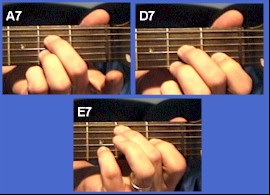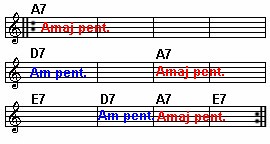Scroll through the lesson and click on notation/video/audio links to load the interactive players.
Please subscribe to get full access to all lessons for only $7.95/month PLUS 1 week free trial.

Riff Interactive lessons are
LESS expensive and
MORE interactive than alternatives!
More Info
|
|

Jam Sessions - All
Blues Styles
Lesson 3 - Blues Shuffle in
A Lesson
Sample
Lyle:
This lesson will show you ways to play and jam a blues progression in A. The basic blues
progression has 12 measures or bars. Each bar has 4
beats:
chord
chart

Lyle: Here's your looping jam track you'll be
jamming to:
Jam
Track - Blues Shuffle in A
Lyle:
First you'll learn a couple ways to play the rhythm guitar to this jam. Here's
the chords I suggest you use:
chords
chords

Lyle: Here's how I'd like you to learn to play
these chords with the jam
track:
rhythm riff
Lyle:
Try using a plain clean sound for this rhythm riff. Here's a close up video clip
of this strum pattern:
strum pattern
Lyle:
Here's a video for the strumming pattern for the whole progression using the
pattern from above:
rhythm riff
Dave: What kind of guitar is that you're playing in the
strum pattern video?Lyle:
Brian Moore Custom i9.5
Lyle: Another cool rhythm riff to use is made
from riffs not chords at all. Here's where you'll play each riff for the three
different chords:
rhythm riff 2
Lyle: I
suggest using the bridge pickup and a fair amount of overdrive. You don't need
to add effects. Here's how it all goes against the
progression:
rhythm riff 3
rhythm riff
3
Lyle:
You can use an acoustic or electric guitar for the rhythm riffs with this
jam.
Lyle: Since the chords in the jam are
dominant chords, not minor, then the Major pentatonic scale in A would be a
great choice of scale to use when improvising.
Amaj
pentatonic
Lyle:
Learn this scale and try playing it against the jam track, you'll hear how nice
it sounds with the jam.
Lyle: When playing the blues in any key, major,
dominant, or minor, the minor pentatonic scale almost always works good when
improvising.
Lyle:
Here is a solo I made from the A major and minor pentatonics
combined:
solo
solo
Lyle:
In this solo example I use the A major pentatonic for everything but the "4"
chord, D. The 4 chord is a great place to switch to the minor pentatonic when
you are using the major pent. Why? - Examine the A and A7 chord, it has a C#
which is a major third, found in the major pentatonic scale as well. When you go
to the "4" chord like a D7, the C# turns into a C natural, (the b7 in the D7
chord). The C natural is in the A minor pentatonic. A subtle, yet big difference
when looking to be a little extra melodic with simple blues
riffs.
Lyle: Look at the chord chart again and you'll
see I've made note of this:
chord chart

Lyle: The main thing for you to work on is the
rhythm guitar part for this jam. Being able to play a good rhythm groove is most
important. Then learn to noodle around with the scales and riffs for extra
fun.
Lyle: That's all for this lesson. Have fun
jammin'!
|
<< load notation from left
|
|
<< load audio from left
|
<< load audio from left
|